Hi Gang,
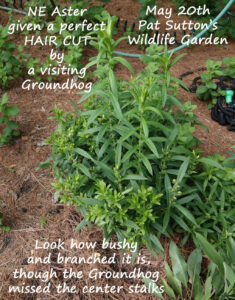 I was not in the garden much this spring due to an unexpected 5-day hospital stay. Boy-oh-boy did the garden get ahead of me quick. During a recent and rejuvenating stroll through I could see that the Groundhog (that has discovered our salad bar) has been busy.
I was not in the garden much this spring due to an unexpected 5-day hospital stay. Boy-oh-boy did the garden get ahead of me quick. During a recent and rejuvenating stroll through I could see that the Groundhog (that has discovered our salad bar) has been busy.
It especially enjoys asters, but hasn’t been too selective nibbling on just about everything. Hmmmmm, I wonder what the garden will look like this year?
If you don’t have a herd of rabbits or a Groundhog or hungry deer, this is the time of year to get out your clippers and give your asters and a few other fall-blooming perennials a HAIR CUT . I cut back New England Aster, Common Blue Wood Aster, Smooth Blue Aster, and Tall Sunflower (my stands of White Wood Aster often do not need haircuts).
Why haircuts, you might ask? It is quite simple. If you want New England Asters and other fall-blooming perennials bushy and full of flowers when they bloom, they need haircuts now, otherwise by fall they will be so top heavy that they are likely to flop over from the weight of flowers on long, unbranched stalks.
Thirty plus years Karen Williams, owner of Flora for Fauna (native plant nursery), shared this sage advice with me about maintaining one of my favorite native perennials, New England Aster, and I’m about to share it with you. Though this post is for folks with plants that are several years old and flourishing, not for brand, spanking new plants that have just been put into the ground this year.
NEW ENGLAND ASTER
2 HAIR CUTS: (roughly) Memorial Day & 4th of July

New England Aster can get very tall and top heavy by the time it blooms in the fall. And the last thing any of us want is for its lovely spread of glowing purple flowers, nectar, and joy to be laying on the ground come fall.
To help it grow into a many-branched, bushy plant instead of a tall, gangly, top-heavy plant, all you need to do is to give it 2 hair cuts on or around the 1st two holidays of the growing season: Memorial Day and 4th of July. Of course these dates are not single-day events, but roughly when you want to give New England Aster its hair cuts. Too, you can be the judge if you need to do your hair cuts earlier, or even if the 2nd haircut is needed. Know that you can jump start the process by several weeks to a month some years!
As a wildlife gardener I don’t clean up and toss the cuttings, but instead leave them lay on the ground at the base of the plant. That way any caterpillars that went for a tumble with the cuttings can climb back onto the plant and continue to munch. Doug Tallamy (author of How Can I Help?, Bringing Nature Home, Nature’s Best Hope, and The Nature of Oaks) shares that 100 species of butterflies and moths lay their eggs on our native asters in this ecoregion, making asters one of the TOP Keystone Native Plants used by butterflies and moths for egg laying. Don’t be surprised if some of your cuttings take root and become additional asters!
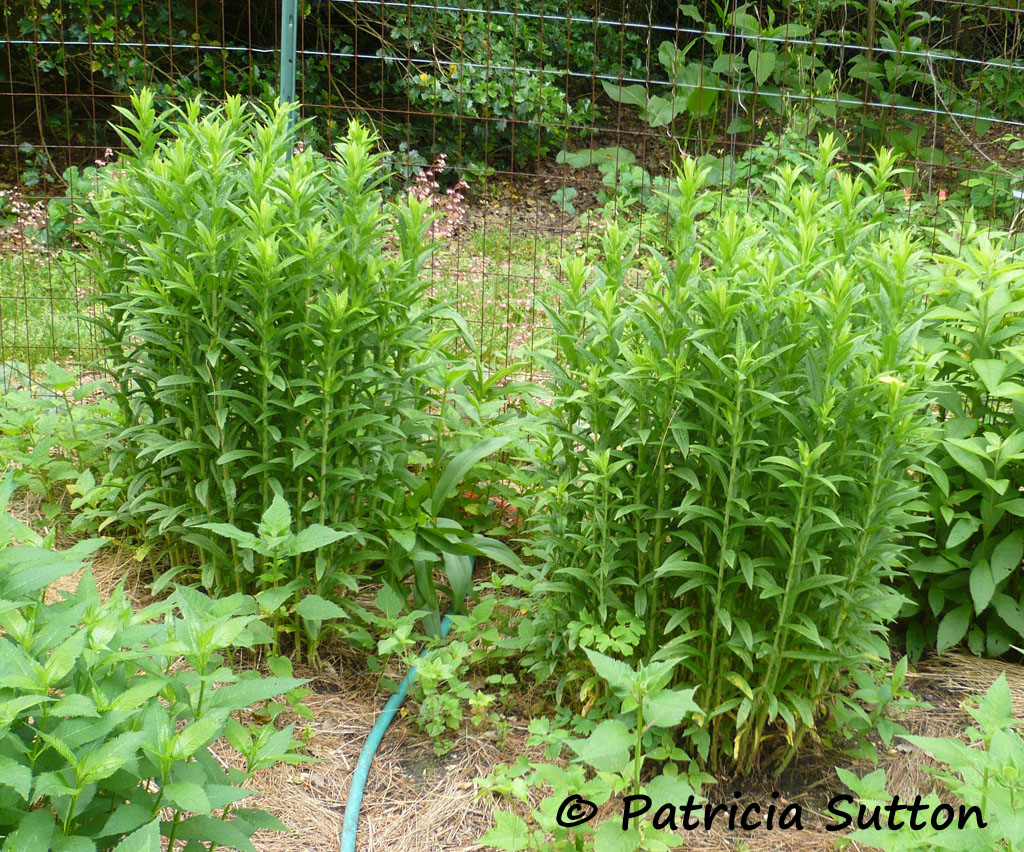

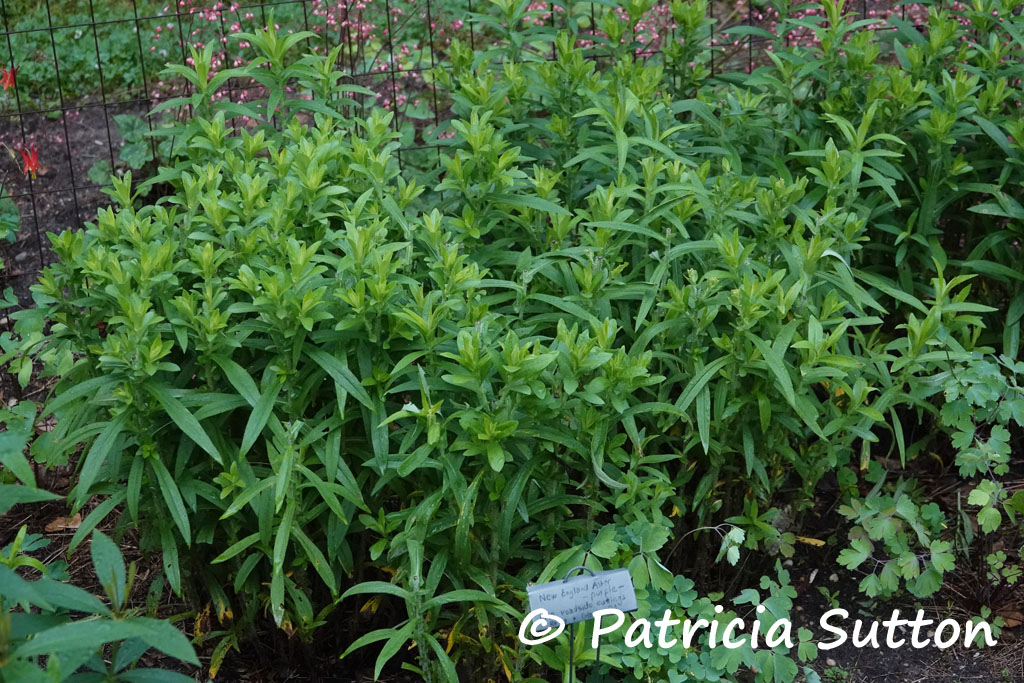
Around Memorial Day, I cut each stem 1/2 (or 2/3) off (or about a foot or two off the top, depending on how tall it is, if that is easier for you to remember). I use big shears and just chop away. What happens next is that each cut plant stem sends out 2 or more new shoots where it has been cut, in other words it branches and becomes more bushy!
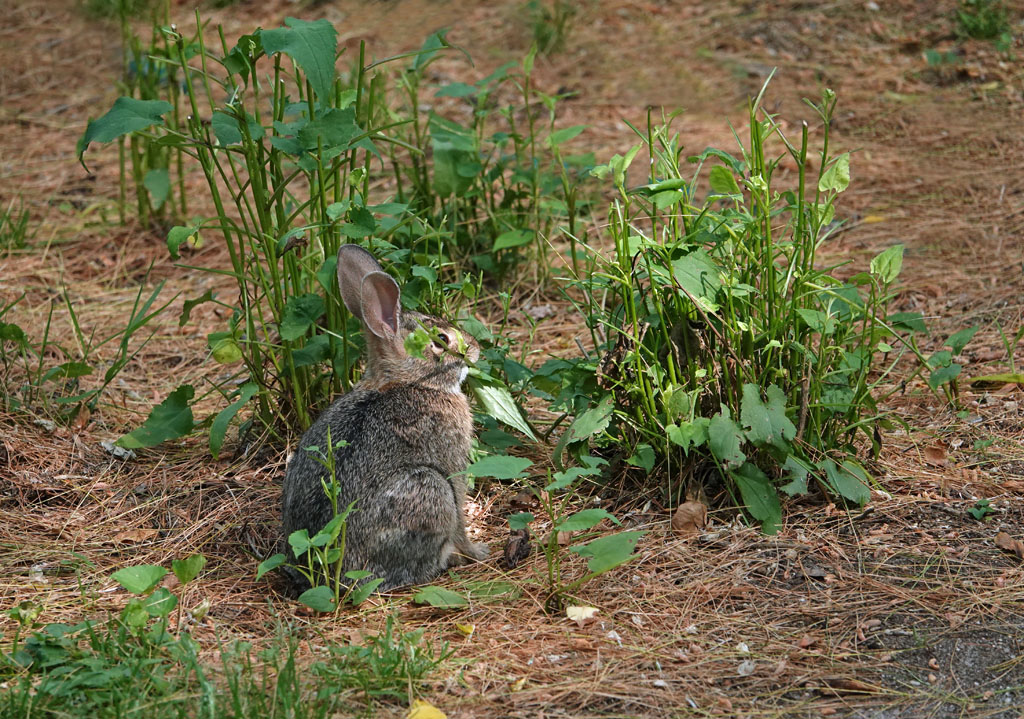
Some of my asters get regular haircuts from plentiful E. Cottontails (they must think our yard is one large salad bowl crafted just for them). I’ve planted the lovely fall-blooming, shade loving Common Blue Wood Aster, Symphyotrichum cordifolium, under our Tulip Tree and in our woods. Despite hungry rabbits it has flourished and spread into other beds, our meadow, the perennial garden, and elsewhere and that pleases me. It is so plentiful that it keeps the rabbits busy and away from most other asters. We’ve fenced our yard, so deer are not an issue for us. But other gardeners share that deer routinely give their asters hair cuts. Our visiting Groundhog arrived in 2020 with the Pandemic. It has been an “on again, off again” garden visitor, disappearing for months at a time only to return and appear quite at home . . . like this late April and May.
If needed, around 4th of July, I give my plants their 2nd hair cut (not back to the 1st cut, but cutting back some of the new growth since Memorial Day). You may want to be more creative for this hair cut and cut the many stems in your plant different lengths. For instance, give the stems in the foreground more of a hair cut, the stems in the middle less of a hair cut, and the stems in the back just a little hair cut. This way your plant stems will bloom at different heights.
You may find that some plants haven’t grown as tall as others, so you may choose to pass on the 2nd hair cut for some plants. If so, you’ll find that these plants will bloom earlier. This staggers the blooming period so that you have New England Aster nectar, color, and joy far longer in your wildlife garden.

A bit more advice: once given hair cuts, New England Aster has “ugly legs.” The stems below the 1st haircut look “not so nice” . . . the leaves darken and fall off and the stems are quite bare. So you’ll want to have other perennials in the foreground blocking that view, so you’re not looking at ugly bare legs.
You can give 1-2 haircuts to some other fall-blooming perennials that grow tall and flop, so they’ll instead branch and become more bushy:
Goldenrod
Sedum
Sunflower
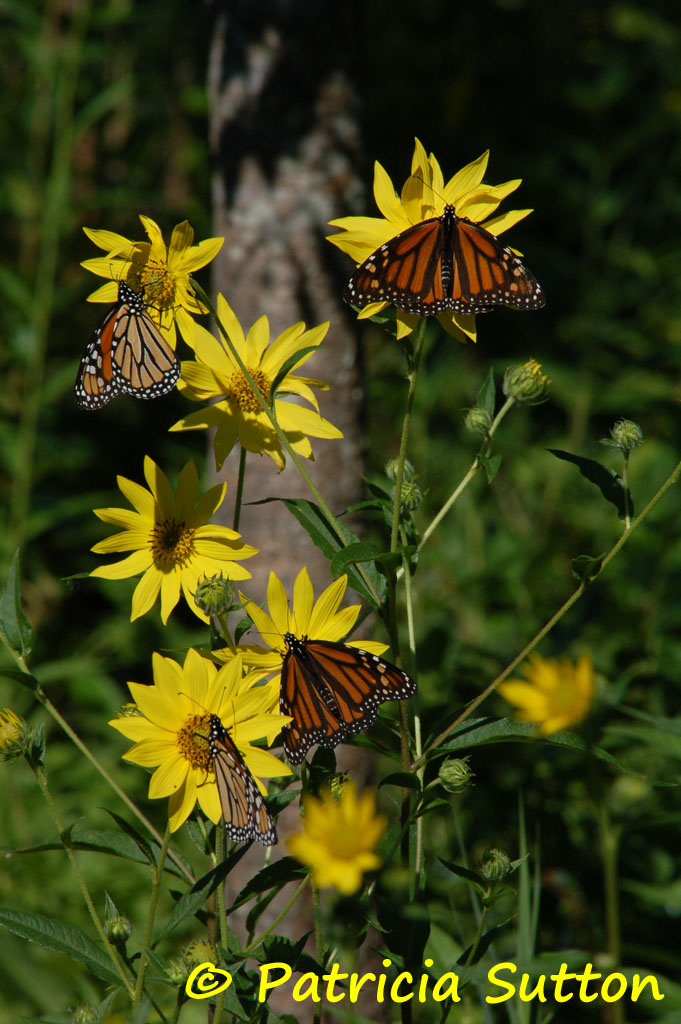

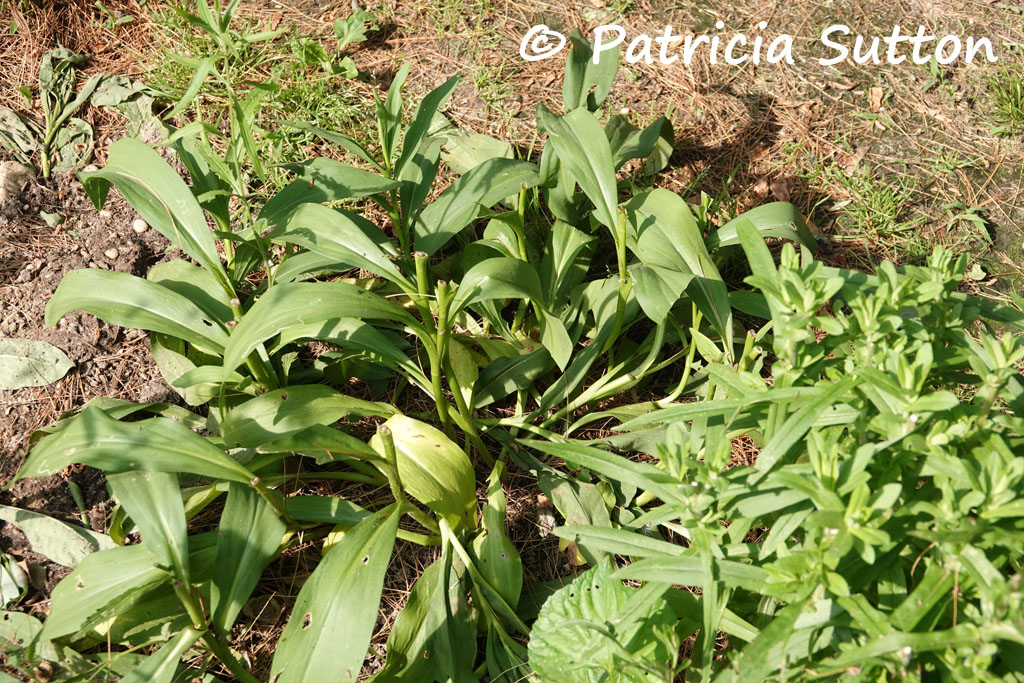
For some summer-blooming plants that grow too tall for your garden, you can give them one haircut around Memorial Day, forcing them to branch, become bushier, and bloom lower. I sometimes do this with some of my favorite summer nectar plants so that I have an easier time seeing and photographing pollinators on them:
Culver’s Root
Garden Phlox (I tried this for the 1st time in 2023)
Ironweed
Joe-pye-weed
Sneezeweed
Blue Vervain
various Bonesets

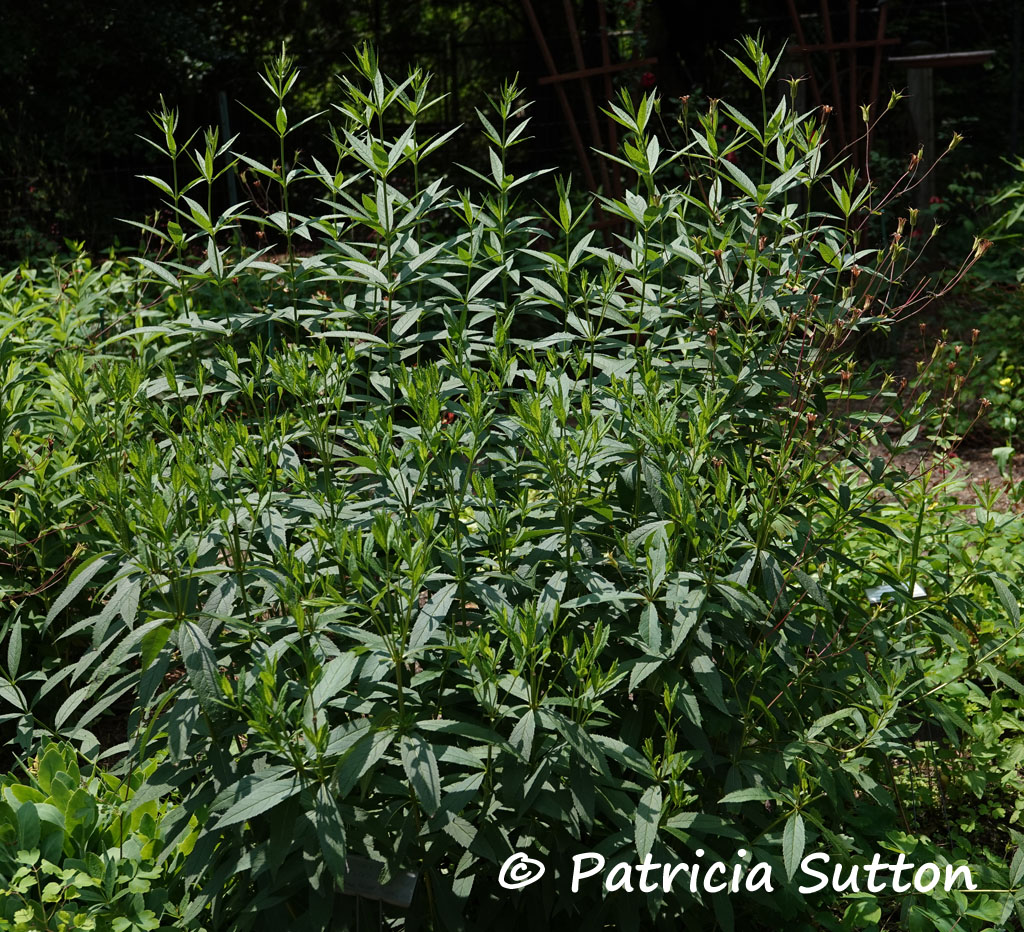
You can always experiment on other fall-blooming perennials that have flopped in your garden. If you’re not sure how hair cuts will turn out on plants other than those I’ve mentioned, try giving a hair cut to one stem ONLY (or if you have several plants of Cut-leafed Coneflower, for example, in your garden, give one of them hair cuts so you can compare results with your uncut plants). Then see how your plant reacts and whether you like the results.
Don’t hesitate to ask a question, but please use the Comment Box at the end of this post, so others can benefit from your question and my answer. Maybe scroll down through previous questions; you may find that your question is already answered.
Happy Wildlife Gardening,
Pat
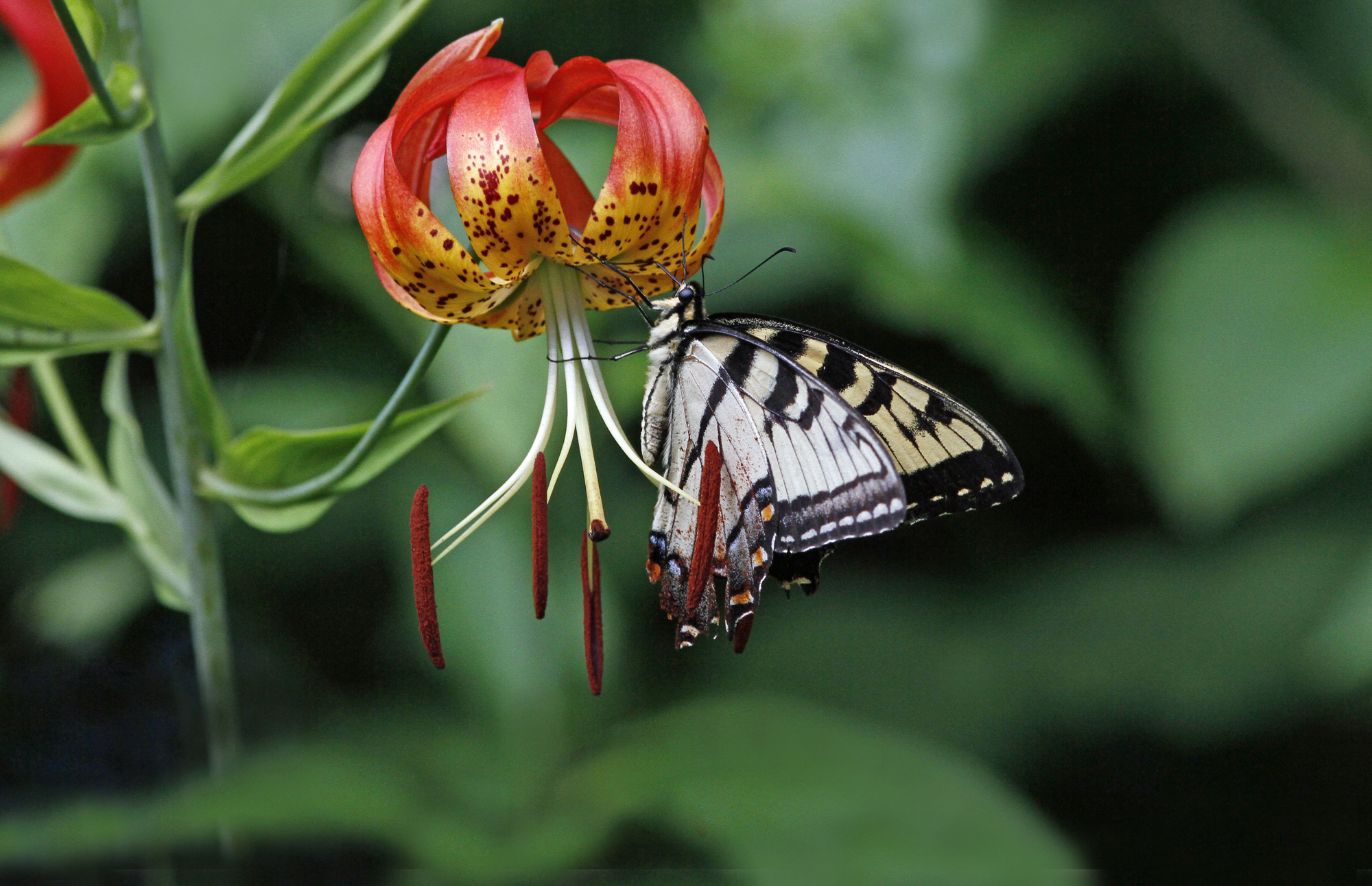
Thanks for the reminder Pat. The deer are my barbers!
Donna, since my garden and woods are fenced I often forget about deer browse. Thanks for that reminder! Many folks with nibbling deer have their perennials given hair cuts on a regular basis with some interesting results.
Just commented on a post that mentioned “Chelsea Chop” and I mentioned that the deer help me out, lol!
Hi Maida, Yes deer can beat us to “Haircuts.” I have a 6′ tall chainlink fence around my perennial garden, so deer can not get in. But rabbits are an issue. This year they nibbled my Common Blue Wood Asters (in many places) within an inch of their life. When this happens, the plant puts more energy down into the roots and the next year’s plants will be nice and robust. Too, some nibbled plants bloomed much later than they normally would have.
I have Bee Balm that wants to fall over. would that take a hair cut on be dates mentioned?
Joanne, Bee Balm is NOT a fall-blooming plant, so NO, you don’t want to give it a haircut . .. or you’ll miss all those lovely blooms.
Any ideas about my peonies, which are currently top heavy, for next year, other than staking them on a trellis?
Hi Mark, Peonies are lovely but not native. Sorry, my expertise is with native plants. BUT, that said, a great book that you’ll want to get than can answer your question about Peonies and many other non-native plants (and some natives too) is Tracy DiSabato-Aust’s book, The Well-Tended Perennial Garden. Get it and let us know what you learn.
Consensus is stakes and twine, light fencing or netting.
Pat, I want to thank you for pointing out that pruning perennials too late in the season may discourage the pollinators from deriving the benefit from the plant.
Hi Elle, YES, you want to be careful you don’t lose out on blossoms by cutting plants at the wrong time.
Will some of my “weedy” asters likewise benefit from this “sage” advice?
Hi Tony,
Not sure. I’ve been tempted to do this with my fall-blooming Common Blue Wood Aster. We might each try it with some of our plants and see if we like the results. Happy Gardening!
Tony, I did give haircuts to all my fall-blooming asters, including Common Blue Wood Aster and I am looking forward to bushier plants with even more blooms!
We went into the woods and snatched a beautiful NEA and planted it in our garden. They spread like wildfire and quickly over took everything. This spring we tore out roots where they did not belong and contained it to quickly realize we need to do this all through the growing season. Now I am going to take your advice and hopefully bush it out at the bottom. We love this free plant and so do the hummers, butterflies and bees. Thanks for your article on this well known plant, but often not put into backyard gardens.
Hi Bridgett,
I haven’t found that my New England Aster spreads from roots, but instead each clump gets bigger and bigger and bigger — and benefits from divisions ever few years. When I give New England Aster it’s haircuts, some times those haircuts take root and become new plants.
But I have found that the native New York Aster spreads with a vengeance from roots. It actually freaked me out and I dug it up from my “formal” gardens. Each year some comes back from a piece of root I missed. It sounds like the plant you found in the wild was New York Aster and not New England Aster. Both benefit from haircuts.
Happy Gardening, Pat
One of my gardening gang members asked: Pat, don’t (Pearl Crescent) caterpillars feed on NE Aster (amongst others)? By trimming the asters, wouldn’t I be destroying any caterpillars that are feeding on the asters?
I replied to her: You are right, Pearl Crescents and many other species lay their eggs on native asters (according to Doug Tallamy 112 butterflies & moths lay their eggs on native asters – to see the complete list of Tallamy’s TOP 20 native perennials and TOP 20 native woody plants used by our butterflies and moths go to his website: http://www.bringingnaturehome.net/what-to-plant.html).
Because of this, when I perform the “hair cut” I let the clippings lay at the base of the plant. That way any caterpillars can crawl back up on live, healthy growth.
Happy Gardening,
Pat
Garden Gang member, Debbie Hendershot, from Columbia, NJ asked this:
Hi Pat,
Do you cut your common milkweed now (early June)?
Mine is ready to bloom its flowers (all are in blossom stage).
Do you only cut some or all?
I replied:
Hi Debbie,
In order to have Common Milkweed blooming later and full of lush growth for egg-laying Monarchs later when they are more plentiful, some people give their patch a partial haircut. You can see this process in the wild when a farmer mows a field with Common Milkweed growing in it and the stand comes back lusher than ever later in the summer. I’m never quite sure when to give Common Milkweed a haircut Sometimes I’ve cut some of my patch and it doesn’t regenerate (send up new growth), so I’m fearful of giving it all a haircut. I found one website that shared the following that leads me to believe that the best time to give Common Milkweed a haircut is early June:
“Common milkweed (Asclepias syriaca) responds well to mowing. My best experience mowing common milkweed was with a dairy farmer who harvested first cutting from a hay field (over 100 acres) where milkweed was very common. First cutting was lush and ready early in June. Milkweed typically emerges from the ground the first week in May. In many years the monarchs are only just arriving in early June so the larva and pupa death from the mowing are minimal if at all. The pleasant surprise was the milkweed fully recovered and bloomed late July instead of July 1 and produced a full crop of seed although matured a week or two later than other wild milkweed. [from: http://www.ourhabitatgarden.org/creatures/milkweed-growing.html ]
So, give it a try now in early June, but maybe not your entire patch . . . in case it doesn’t regenerate.
Happy Gardening,
Pat
I think you can pinch/prune back Monarda in spring–I did this, because in my New England garden the poor bee balm got chewed up by awful worms in the buds last year. I read somebody reduced the worms ( tobacco worms?) by pruning the beel balm back so it bloomed later. This indeed seemed to help, and the bee balm I did not prune got ruined again by the worms. The ones I did prune bloomed very well and for a long time, and are being visited by swallowtails and hummingbirds (and bees of course).
Hi Lisa, Thanks for this great advice. Sorry you have caterpillars decimating your Bee Balm. Maybe photo one or several and send them into Bug Guide to help you with an ID. I don’t think they are Tobacco Worms (which become one of the lovely Sphinx Moths), since they lay their eggs on plants that are in the Tomato and / or Tobacco Family. Happy Gardening!
Hi Pat -I read somewhere a long time ago the you can pinch back bee balm up until July , so that’s what I’ve always done because mine was getting really tall and leggy and falling over . I haven’t really done it according to a calendar date -I just go out to the garden and pinch it right above a set of leaves … I will do this a few times over the course of the late spring/early summer , and then I stop come July . I do get a lot of blooms so it seems to work .
Hi Liz, GOOD to hear from you! And thanks for sharing your Bee Balm pinching tip! Some years I deadhead mine (after each blossom blooms and fades) and some years I do not get a chance to get to it. When I deadhead it, I do get another flush of blossoms (that I am hugely grateful for). Your “Pinching Back” technique is intriguing. I’ll certainly try it for bushier plants with more blossoms! Thanks a bunch for sharing!!!
Should we be cutting them even if they are in bloom?
Hi Donna, New England Asters are fall bloomiers, hence these early haircuts so they branch and become bushier by the time they bloom. I can’t think of any of my spring blooming natives that I’d cut.
Hello, Enjoying the conversation. I cut back New York Ironweed today, and looking at the Helianthus, of which I have two varities in the garden. What do you think? Give it a chop for the fall blooming floppsies?
Hi Kim, I’ve cut back my Tall (or Giant) Sunflower,Helianthus giganteus, and been spared the flop! So, go for it. If you’re not sure, you can always cut back some of them and see how you like the results.
Hi Pat,
How do you divide the NE Asters?
Dig up the entire plant then split?
Thanks!
Hi Ellen,
New England Asters are easy to divide. I take a shovel and slice the plant in half (in 2 chunks) or into 4 pieces/chunks. I leave one piece in place and pry out the other 1/2 (or 3 pieces). The piece left in place, if not too disturbed, will bloom at the typical time. The pieces pulled from the ground and moved to new spots (or given away to friends) will bloom slightly later, giving your garden more blooming time for New England Aster. Have fun with it. Happy Gardening, Pat
thanks for the tip! I never thought to haircut the asters!! and yes, ours flop all over by fall. will go give them a trim today. I also have trouble identifying them w/goldenrod
Will this haircut method work for Cup Plant?
Greetings! Any suggestions to get rid of the rose chaffer beetles that are eating all the flowers on my nine bark? Neem oil does nothing and the birds stay clear since there’s something toxic about these bugs. I’m hand picking them off but losing the battle! Any suggestions? Thanks, Pat. I appreciate all your tips!
Lisa – Dennis Township
Hi Lisa,
I am sorry that I am just seeing your question now. I have a lovely Common Ninebark and have not noticed the rose chaffer beetles (yet). EEK! Sorry, but I haven’t had to address this problem, so don’t have a solution for you. Sounds like you are tackling them the way I would.
Great advice! This is the first full year I’m following these trimming tips (last year didn’t get these tips until July) and the plants are lush and doing great.
Hi Pat,
Thank you for the tips on trimming the asters. I’ve trimmed half of them for the first time this year. I look forward to their more bushy look and plentiful blooms.
In the past, I’ve put up tall metal holders that link together. That has worked well. It prevents the plant from falling over. The bees love having the aster nectar throughout the Fall. It also makes it easy to photograph the bees when they are moving slowly during cooler weather.
I’ve had a beautiful patch of Black Eyed Susan‘s for many years. Last season and this season they seem to be thinning out quite a bit.
Do you know of any disease that is affecting these plants lately? Also, some of them seem to have been eaten. What critters eat them?
The patch faces east, south-east, so it gets plenty of sunlight. I water them as needed. New plantings never seem to last.
Do you know of a garden center that sells single Black Eyed Susans instead of a large bunch?
I look forward to your answers.
Thanks.
David Lowenstern
Hi David, I do not have Black-eyed Susans in my garden. Years ago I chose not to plant them, knowing how aggressive they can be. But I have had a problem with my Mountain Mint patch thinning out. I wonder if you’ll find that the roots have just become too rootbound. That’s what I found with my Mountain Mint. Rather than dig them up and thin my Mountain Mint, I laid a fresh layer of Compost on top of the bed. That seemed to really help. Maybe it will work with your Black-eyed Susans.
I am also wondering about cup plant haircuts. My cups are gigantic by the end of July.
Hi Sarah, I do not have Cup Plant in my garden, so I have not experimented with it. Next growing season, why don’t you try cutting back a few stalks and see what you think about the results. I’ve done that with some of my plants, and then decided I either liked the results or did not like the results.
Any idea if Mountain Mint (an amazing pollinator plant) would benefit from a May haircut? Mine is already flopping over despite surrounding it with a short twine fence
Hi Nicolas, I’ve never given my Mountain Mint a haircut, but maybe I have a different more low-growing species than you have. Mine is Clustered Mountain Mint. I find it grows about 2-3′ high and remains upright / stiff. YES, it is an amazing pollinator plant, one of my favorites.
I just found this site when I was searching for an answer to why my New England asters are blooming so early (beginning mid-June. ) I still don’t know the answer to that question, but I know they’re going to get a couple of “haircuts” next year! Thanks for all the great advice! Love your site!
I didn’t realize I should give my ironweed a haircut so should I do one now? They are budding.
Hi Ann, you don’t want to cut perennials back when they’re in bud or about to bloom. It’s something you’d do long before blooming time. The hair cuts will delay blooming a bit, but you don’t want to do it “just” before budding/blooming.
Do you know if Compass Plant would benefit from a haircut. We have them in a demonstration garden and they always fall over. And are a bear to try to stake because they are so heavy.
Hi Tavane, I do not have Compass Plant in my garden, so I have not experimented with it. Next growing season, why don’t you try cutting back a few stalks and see what you think with the results. I’ve done that with some of my plants, and then decided I either liked the results or did not like the results.
That was what we decided to do if I did not hear back from you. Thanks.
As I write this, we have had almost no rain in the month of May in Easton, Pa. Not sure if I should give hair cuts.
Hi Marilyn,I just heard from another wildlife gardener in northwestern NJ with the same predicament, no rain in May and very dry. Yes, for sure, you can be the judge of whether your asters are ready (or NOT) for haircuts. If they are not at all tall (only 1′ in northwestern NJ), leave them be for now. Asters, that are bunch forming like New England Aster (where the base of stems and roots just keeps getting bigger and bigger and bigger), respond very well to divisions. Though in such dry conditions, you’d have to pamper them after dividing them, so maybe wait until a wet spring or wet fall to tackle that. Thanks for sharing your question! Pat
I have a Calico Aster in its second year that is growing tall, wide and bushy like a shrub, leaning on some other plants. Should I try this 2 hair cut schedule next year?
Hi Susan, Yes it sounds like your Calico Aster has grown quite well and next year could use the 2 haircuts to become even more bushy (especially since it is so tall now that it is leaning against other plants). But you decide. Sounds like it naturally grew quite bushy.
Thank you, Pat, for this timely notice and all of your wonderful, knowledgeable information that you dispense to all of us.
Your advice has helped me immensely in my gardening activities. 🙂 🌼 🐝
David Lowenstern
Hi David, I am happy to share information that has helped my wildlife gardens be as robust as they can possibly be. It is a treat for me to know and be able to help fellow wildlife gardeners. In our interactions we are all “growing” more wildlife gardeners and wildlife gardens!
Hi Pat,
I have Silphium perfoliatum, cup plant in my garden in Southeastern Pennsylvania. I give the whole plant a chop in late May, then a staggered chop in early July. It always blooms happily, but I find I still need to tie it to the fence to “reign” it in a bit 🙂
It’s a heavy hitter for pollinators.
Hi Linda, Thanks so much for sharing that Cup Plant is another native that we can give haircuts to with great success! Much appreciated!!!
Pokeweed and Common Milkweed: do you cut your Pokeweed? I read your comment on Common Milkweed; last year I trimmed a few plants but they did not branch, they just grew a single stalk on an angle which looked strange and leaned over. I like some of my pokeweed in the wetlands to get tall like trees, but I also want some shorter, bushier near my mailbox.
Hi Mary Ellen, Hmmmmmmmmmmmm! I let my Pokeweed in select spots get tall and bushy. They end up as really robust perches for birds, which is great because so many birds feast on their juicy fruits when they ripen in fall at the peak of migration. I’ve never tried giving my Pokeweed a haircut, but let us know how that works for you. Regarding Common Milkweed, a friend shared with me this spring that she pulls quite a bit of it out in May, so that new shoots will come up from the same root(s). These new shoots will be juicy and fresh for later in the year when Monarchs are more abundant. I tried it myself in May in my garden, and pulled up @40 stalks (out of 100s). I inspected each one carefully, every leaf and flower bud, looking for Monarch eggs and tiny caterpillars. I did find 2 teensy tiny caterpillars. I cut a largish circle around each one and took that circle of leaf and pinned it to a leaf on a still-standing stalk. I’ll let you know how much regeneration I get (a work in progress).
Hi Pat,
Most comments are from past years- did I miss any about the time to cut back my spreading wild sunflower/Jerusalem Artichoke ? It’s very leggy right now.
Thank you for sharing your knowledge!
-Mary Beth H
Hi Mary Beth, yes I cut back my Tall (or Giant) Sunflower, Helianthus giganteus, a native perennial that is a fall bloomer, at the same time that I cut back my asters. This native is featured throughout my post. There are many native sunflowers. If yours is a fall bloomer, then you’d want to do the same. Jerusalem Artichoke is not a native plant, so I’m not sure what is best for it, but probably the same (if it is a fall bloomer).